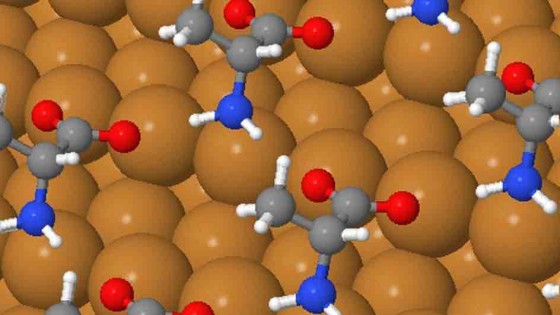New research demonstrates how chiral metal surfaces may provide a novel approach to the preparation of medical materials

New research demonstrates how chiral metal surfaces may provide a novel approach to the preparation of medical materials.
These metal surfaces, with original chirality, provide new ways to control chiral chemistry, while opening the hatch to intriguing possibilities of using heterogeneous catalysts in drug synthesis. Such surfaces could also become the basis for innovative bio-sensing technologies.
A chiral bone, like any of our hands, is one that cannot overlap its mirror image. Chirality is a fundamental characteristic of biochemistry - the building blocks of life, the amino acids and sugars, are chiral molecules: their spatial molecular structures can exist either in a "left-handed" or "right-handed" form (so-called "enantiomers").
A living organism may react differently to each of the two enantiomers of a chiral substance. This fact is crucially important in the case of drugs, for which the medical effect is often closely related to only one of the enantiomers of the drug molecule. Therefore, the control of chirality is a crucial factor in drug synthesis.
The research regarding the control of chiral synthesis focuses mainly on the use of homogeneous catalysts, where the catalyst is in the same medium as the reactants and the products of the reaction, such as a liquid solution added to a reaction occurring in another liquid solution. However, this process involves serious practical challenges to recover the valuable catalyst from the mixture. In order to avoid this problem, an effective alternative would be the use of a solid surface heterogeneous catalyst - the type of catalysts used in catalytic converters found in the exhaust system of vehicles, as well as in industrial processes such as the preparation of ammonia and synthetic fuel. In this case, the question is how to achieve enantiomeric selectivity on the surface - that is, the acceptance of one enantiomer exclusively or in considerable excess, relative to the other enantiomer.
In order to help and answer this question, scientists from the University of Cambridge are investigating the spontaneous self-organization of a simple chiral amino acid, alanine, into ordered molecular arrays on the surfaces of copper single crystals. Thanks to a powerful scanning tunneling microscope, capable of distinguishing individual atoms and molecules, their research reveals the various mechanisms for obtaining chirality while obtaining important insights regarding the receipt of chirality, its control, and its utilization for scientific purposes.
Dr. Stephen Driver, from the Department of Chemistry at the University of Cambridge, who led the experimental part of the research, says: "We began to investigate two distinct scenarios - in one of the scenarios, the surface is non-chiral, so any chirality that emerges must be due to the chirality of the alanine molecule itself only . In the second scenario, we used a surface that is itself chiral. Now the question was reduced to: Will the two enantiomers of alanine behave differently in the reaction with the chiral surface?"
The researchers found that when a non-chiral surface was used, the alanine could independently organize into two separate patterns. For one of them, the independent organization is driven by hydrogen bonds between the molecules, where the chiral center has no differentiating effect on the resulting ordered array. For the second structure, a network of long-range chiral boundaries embedded within the array is obtained, and it is the chirality of the boundary itself that affects the molecular chirality.
The researcher explains: "The meaning is that the chiral center has a direct effect on the packing arrangement of two neighboring alanine molecules at the boundary, and that the chirality of this pair advances to the neighboring pair, and so on and so forth, so that the chiral boundary is built up and goes on for a long time."
The chiral surface is created simply by choosing a surface orientation far from all the symmetry planes of the metal crystal. When the researchers added alanine, they found that the surface changed its local orientation to form nanoscale whiskers. The two separate enantiomers of alanine organize independently into different chiral patterns, indicating a powerful structural effect with enantiomeric selectivity. This "proof of principle" could be utilized in the fields of chiral recognition, chiral synthesis (creating a chiral product from non-chiral reactants), and chiral separation.
The researcher adds: "It seems as if alanine is able to create a convenient chiral binding site for itself. The copper surface has the flexibility required to adjust the shape of the alanine molecule, and this shape is different for each of the separate enantiomers." The findings indicate that a certain surface directionality can lead to obtaining ordered and stable structures from one of the enantiomers, but not from the other: the exact conditions for obtaining chiral chemical effects.
Adds one of the researchers: "matching the exact surface to the appropriate molecule can lead to strong effects of enantiomeric selectivity. There is a real basis here for a breakthrough technology in the pharmaceutical sector. Our research may be of great interest to all pharmaceutical companies."
The news about the study
